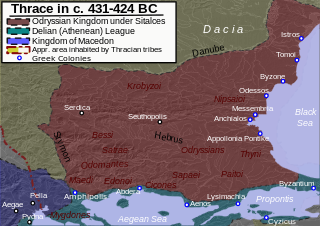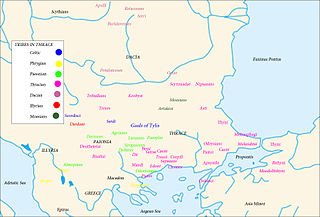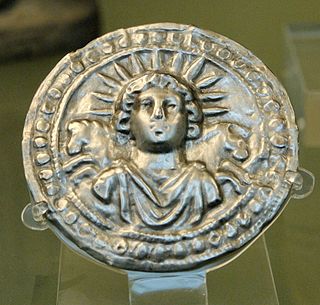
Cavarus was a Celtic [1] king in Thrace and the last king of Tylis. Under Cavarus, Tylis was destroyed by the Thracians in 212 BC. [2]

Cavarus was a Celtic [1] king in Thrace and the last king of Tylis. Under Cavarus, Tylis was destroyed by the Thracians in 212 BC. [2]

The Boii were a Celtic tribe of the later Iron Age, attested at various times in Cisalpine Gaul, Pannonia, present-day Bavaria, in and around present-day Bohemia, parts of present-day Slovakia and Poland, and Gallia Narbonensis.

Philip V was king of the ancient Greek kingdom of Macedon from 221 to 179 BC. Philip's reign was principally marked by the Social War in Greece and a struggle with the emerging power of the Roman Republic. He would lead Macedon against Rome in the First and Second Macedonian Wars. While he lost the latter, Philip later allied with Rome against Antiochus III in the Roman-Seleucid War. He died in 179 BC from illness after efforts to recover the military and economic condition of Macedonia and passed the throne onto his elder son, Perseus of Macedon.

The Kingdom of Pergamon, Pergamene Kingdom, or Attalid kingdom was a Greek state during the Hellenistic period that ruled much of the Western part of Asia Minor from its capital city of Pergamon. It was ruled by the Attalid dynasty.

The Odrysian kingdom was an ancient Thracian state that thrived between the early 5th century BC and the early 3rd / late 1st century BC. Located in present-day Bulgaria, southeastern Romania, northern Greece and European Turkey, it was a tribal amalgam dominated by the Odrysians that was the first large political entity to develop in the eastern Balkans.

Tylis or Tyle was a capital of a short-lived Balkan state mentioned by Polybius that was founded by Celts led by Comontorius in the 3rd century BC. Following their invasion of Thrace and Greece in 279 BC, the Gauls were defeated by the Macedonian king Antigonus II Gonatas in the Battle of Lysimachia in 277 BC, after which they turned inland to Thrace and founded their kingdom at Tylis. It was located near the eastern edge of the Haemus (Balkan) Mountains in what is now eastern Bulgaria. Some bands of Celts, namely the Tectosages, Tolistobogii and Trocmi, did not settle in Thrace, but crossed into Asia Minor to become known as the Galatians. The last king of Tylis was Cavarus who maintained good relations with the city of Byzantium. His capital was destroyed by the Thracians in 212 BC and this was also the end of his kingdom. The modern Bulgarian village of Tulovo in Stara Zagora Province now occupies the site.
Lysimachia was an important Hellenistic Greek town on the north-western extremity of the Thracian Chersonese in the neck where the peninsula joins the mainland in what is now the European part of Turkey, not far from the bay of Melas. It is located near the modern village of Bolayır, not at Hexamili as previously thought.

Tile Ridge is a partly ice-free ridge of elevation 240 m in Dryanovo Heights, Greenwich Island in the South Shetland Islands, Antarctica.

The Cretan War was fought by King Philip V of Macedon, the Aetolian League, many Cretan cities and Spartan pirates against the forces of Rhodes and later Attalus I of Pergamum, Byzantium, Cyzicus, Athens, and Knossos.

Kabile or Cabyle is a village in southeastern Bulgaria, part of the Tundzha municipality, Yambol Province.

Tolistobogii is the name used by the Roman historian, Livy, for one of the three ancient Gallic tribes of Galatia in central Asia Minor, together with the Trocmi and Tectosages. The tribe entered Anatolia in 279 BC as a contingent of Celtic raiders from the Danube region, and settled in those regions of Phrygia which would later become part of the Roman province of Galatia. The Galatians retained their Celtic language through the 4th century AD, when Saint Jerome mentions that the Galatians still spoke a Celtic language in his times.
Celticisation, or Celticization, was historically the process of conquering and assimilating by the ancient Celts, or via cultural exchange driven by proximity and trade. Today, as the Celtic inhabited-areas significantly differ, the term still refers to making something Celtic, usually focusing around the Celtic nations and their languages.
Cotys IV was a king of the Odrysians in Thrace from before 171 until after 166 BC. He was the son of Seuthes V and succeeded either his father or another king, Amadocus III, who was captured by the Macedonians in 184 BC. While the survival of a specifically Odrysian state past the mid-3rd century has been doubted, Cotys IV is described as an Odrysian by Polybius and Livy, although the term may have been used in a less than specific sense.

The history of Thracian warfare spans from the 10th century BC up to the 1st century AD in the region defined by Ancient Greek and Latin historians as Thrace. It concerns the armed conflicts of the Thracian tribes and their kingdoms in the Balkans. Apart from conflicts between Thracians and neighboring nations and tribes, numerous wars were recorded among Thracian tribes.

Monunius was an Illyrian king of the Dardanian State who lived in the late 3rd century BC and early 2nd century BC. Monunius attested first in 176 BC was the son of Longarus, a Dardanian king who caused much trouble to Macedonia from 230 BC onwards. He succeeded his brother Bato to the Dardanian throne. Monunius was known for his victory he inflicted on the Bastarnae during the Bastarnae Invasion of Dardania.

Cavarus Point is the mostly ice-covered point on the south side of the entrance to Zimen Inlet and the north side of the entrance to Brentopara Inlet on Oscar II Coast in Graham Land. It is situated on the east coast of Churchill Peninsula. The feature is named after King Cavarus, a Celtic ruler in Thrace.
Comontorius was a Celtic king in Thrace who in 278 BC founded the kingdom of Tylis, imposing a tribute on the city of Byzantium. His successor on the throne was Cavarus under whom Tylis was destroyed by the Thracians in 212 BC.
The Aigosages were a Celtic tribe dwelling on both sides of the Hellespont, first in Thrace and then in Troas and Mysia on the Asian side.
Ciroadas was a king of the Odrysian kingdom of Thrace who may have reigned in the years 212 to 200 BC. According to an anonymous poem in the Greek Anthology, he was defeated by king Philip V of Macedon, who dedicated his booty to the goddess Hecate. This may have happened in the year 205 or 200 BC, as the most probable dates, or in another year of Philip's reign. Ciroadas, who gains the epithet the Bold from the poet, is depicted as an important king of the Odrysians. He may have been the victor in the war against Cavarus, in 212 BC, and the destroyer of the Celtic kingdom of Tylis. According to the dedication, he had several sons, but nothing more is known of his family.